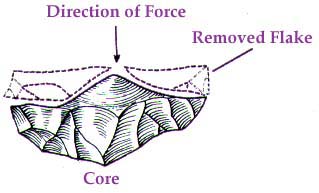 Percussion Flaking
Percussion FlakingWe're looking for high-quality animations
by new or used artists. Contact Wendy.
 Percussion Flaking
Percussion FlakingA core is struck by a hammerstone and a flake falls off. The toolmaker may use the shaped core, in which case it is called a core tool.
Or the flakes may be used to cut with. These are called flake tools.
To strike a flake from a piece of chert, the toolmaker applies a blow to a specific point on the rock, which is called a percussive blow. The energy spreads from the contact point outward without anything to stop it, in the shape of a cone. The energy moves in a wave which is visible as a conchoidal (shell-shaped) fracture pattern
 This method creates blade tools. By applying pressure in one direction with another rock, a long, thin flake is removed. This type of flake is called a blade.
This method creates blade tools. By applying pressure in one direction with another rock, a long, thin flake is removed. This type of flake is called a blade.
Our dinner table knife and fork are part of a long chain begun by our distant ancestors, the prehistoric humans, two-and-a-half million years ago.
Making your own stone tools, or "flintknapping," is very difficult and it takes a lot of practice. It's fun, but it can be dangerous. When you strike two stones together, very sharp pieces can fly off and hurt you. Those who want to learn how to stone tools should seek the supervision of a skilled flintknapper.